Biacore Probe System
| Objektnummer | B00013933 |
|---|---|
| Numéro d'identification | 013933 |
| Nom de l'objet | Biacore Probe System |
| Statut | Stock unit |
Groupe de produits: Life science / Biotechnologie
Statut, conditions de livraison et de paiement
Vérification des appareils
Les appareils d’occasion sont vérifiés par Labexchange Service GmbH avant la livraison. Vous recevez des appareils entièrement fonctionnels.
Délai d'expédition
Les délais de livraison indiqués sont les plus rapides pour l’article en cause. Les délais de fait peuvent varier au cas par cas. Les délais de livraison définitifs sont indiqués dans la confirmation de commande.
Nous offrons des livraisons collectives par principe. Le délai de livraison s’oriente à l’article avec le délai de livraison le plus long. Une livraison partielle est possible par prix additionnel.
Méthodes d'expédition
Courrier, agences d'expédition, autocueillette, livraison par flotte de Labexchange
Conditions de livraison
Prix plus frais d’expédition. Les frais d’expédition indiqués sont à prévoir. Dérogations éventuelles sont possibles.
Si les coûts de transport ne sont pas spécifiés, s'il vous plaît demander séparément les frais de transport. Les frais de transport et d'emballage indiqués se réfèrent à l'itinéraire de transport le moins cher et sont sujets à des augmentations de coûts imprévues. En raison d'événements imprévisibles, les tarifs de transport et les délais de livraison peuvent changer à tout moment et doivent être adaptés à la situation actuelle. Incoterm codage selon les Incoterms 2010: Pour personnes qui viennent chercher les dispositifs elles-mêmes: EXW, pour les expéditions par voie maritime: CFR, par avion: CPT, d'autres expéditions: DAP. Remarque: Nous n'établissons pas des preuves préférentielles/EUR1. Dans le cas d’un enlèvement par vos soins/EXW de pays à l’intérieur ou à l’extérieur de la Union européenne, nous devons conserver 16% de TVA d’acheteur comme dépôt de garantie, jusqu’à ce que nous ayons reçu l’attestation de reception/la prevue de livraison.
Modalités de paiement
Nous n’acceptons pas le paiement par lettre de credit, PayPal, etc. Dans tous les cas le montant est payable sans déduction. Jusqu’au paiement complèt l’équipement reste notre propriété. Un escompte n’est pas accordé.
|
Pays |
Modalités de paiement possible |
Remarque |
|
DE, AT, CH |
Paiement par facture, prépaiement, par carte de credit |
Paiement par facture est possible pour clients professionnels. |
|
NL, BE, LU |
Paiement par facture, prépaiement, par carte de credit |
Paiement par facture est possible pour clients professionnels. |
|
Autre pays |
Prépaiement, par carte de credit |
|
Nos conditions de vente, de livraison et de paiement sont en vigueur. Vous pouvez télécharger les documents ici.
La vente intermédiaire nous est réservée.
Défintion des statuts
Tous articles sont d’occasion, sauf si explicitement défini comme « appareil neuf ».
|
Statut |
Condition |
Remarque |
|
Immédiatement disponible |
Occasion |
L’article a été déjà entièrement vérifié et peut être envoyé directement à vous. |
| En stock |
Occasion |
L'article est en notre stock, mais doit être vérifié avant la livraison par nos techniciens Vous recevez des articles entièrement fonctionnels. |
|
Publié |
Occasion |
L’article est toujours au l’offreur. Nous achetons, vérifions et en fin livrons l’article après votre commande. Le certificat de fonctionnement ainsi que le rapport de service sont inclus à la livraison. |
|
Appareil neuf |
Neuf |
C’est un dispositif neuf. L’article n’est pas utilisé et neuf d’usine. En ce qui concerne des article neufs, la garantie du fabricant est valable. |
|
Labprocure |
Occasion |
Responsable du contenu de l‘offre d’appareil est la société Labprocure GmbH, comme annonceur. Labprocure assume la responsabilité des offres annoncées ici ainsi que des photos et des textes d’offre inclus. Labprocure GmbH, Bruckstraße 58, 72393 Burladingen. |
Firma: Biacore
The following illustrations and descriptions are referring to the instrument model and are drawn from brochures. They are not representing the delivery volume. The exact delivery content you will find only in the offering text.
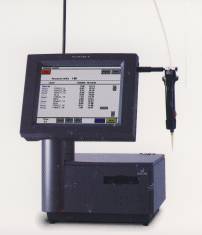
BIACORE P ® P probe , for fast identification of biological activity from fermentationlexpression to purified biomolecule.
Faster Purification Development for Biomolecules
Ø Easy to use
Ø Flexible in application
Ø Robust in performance
Ø Direct identification of biological activity during Isolation and purification
-no sample preparation, labet free
Ø Fast decisions
-immediate result evaluation
-instant savelwaste decisions
Ø Estimation of yield at every stage
Ø Fast Information an activity changes during modification, extraction or purification
-follow activity throughout procedures
Ø Faster than conventional analytical techniques
-Elisa, PAGE, HPLC, etc
BIACORE® probe provides direct identification of biological activity at any stage in a purification process, from fermentation/expression to final purified biomolecule. Identification of the target molecule achieved within minutes. The technique is labet free; no sample preparation is necessary.
A Sensor Probe is coupled covalently wich a biological binding partner or affinity ligand - the detecting molecule. This functionalized probe is exposed to sample, the sample exchanged for reference buffer, and the bound analyte is measured. The probe is re-usable.
BIACORE@probe is designed for rapid routine determination of the presence and active concentration of biomolecules in solutions, at any stage from expression and extraction to final purification. Measurement is based on the ability of the biomolecule in question (the analyte) to bind to a Chosen interactant (the detecting molecule). No label is required. Operation is simple and each measurement takes typically less than 5 minutes, making BIACORE®probe well suited to method development and other application areas where the design of the next step in a process is directly dependent on the results of the previous step. Approximately 100 pl of sample is required, and the measurement is non-invasive so that sample can normally be used for further processing.
The detection principle exploits the optical phenomenon of surface plasmon resonance (SPR), which measures the surface concentration of solute at a gold-liquid Interface (see Appendix B for a technical description). In BIACORE®probe, SPR occurs at the gold-coated tip of an optical fibre (the sensor probe) coated with detecting molecule. When analyte binds to the detecting molecule, an SPR response is measured which is a direct measure of the amount of functionally active analyte in the sample. ("Functional activity" is defined in terms of the ability of the analyte to bind to the detecting molecule BIACOREGprobe will not detect analyte molecules which haue lost this ability.) Typical detecting molecules are high affinity antibodies for specific antigens, although other molecules may be appropriate in specific Gases.
Once the detecting molecule has been attached to the sensor probe, determining the presence or concentration of analyte with BIACORE@probe involves four simple steps (Figure 1-1):
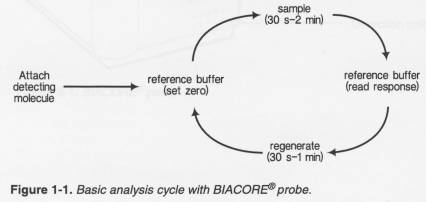
1. Set a zero response with the sensor probe in a suitable reference buffer.
2. Bring the sample into contact with the sensor probe incubate for 30 seconds 2 minutes.
3. Return the sensor probe to reference buffer and read the response (which is a measure of
the amount of analyte bound to the sensor probe).
4. Incubate the sensor probe with regenerating solution for 30 seconds 1 minute to remove
bound analyte in preparation for the next measurement.
The detection principle used in BIACORE probe offers major advantages over conventional methods for biospecific determination of molecules such as ELISA:
BIACORE@probe uses a label-free technology: neither the analyte nor the detecting molecule needs to be labelled, saving time, effort and money. In addition, all steps in an assay are revealed with the same detection principle, providing valuable intra-assay controls (e.g. attachment of the detecting molecule to the sensor probe is monitored in the same way as binding of analyte).
BIACORE®probe uses a non-invasive technology: since the light used to generate the response does not penetrate the sample, measurements can be made on turbid or opaque samples (e.g. cell culture supernatants, fermentation broth, Grude cell extracts).
BIACORE®probe uses an interactive technology: each measurement takes typically less than 5 minutes, so that decisions can be made on the basis of each measurement (e.g. chromatogram fractions can be rapidly scanned to localize the active peak for immediate follow-up processing).
BIACORE®probe consists of the following main components (Figure 2-1):
the detection unit wich Couch screen display
the sensor probe
the optocable connecting the sensor probe to the detection unit
the pipette which serves to bring the Sample to the sensor probe
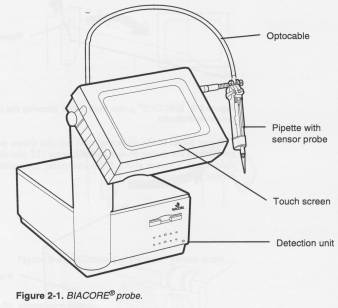
The detection unit
The main body of the detection unit houses the light source (a low temperature halogen lamp), detector and software for registering and interpreting the Signal from the Sensor probe, and a 3.5 " diskette drive for copying data to PC-formatted computer diskettes (See Section 4.7). A green lamp on the front panel indicates that the power is on.
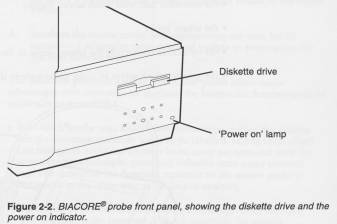
The rear panel of the detection unit has the mains power switch and connectors for mains power and a printer (25-pin computer connector). There is also a 9-pin computer connector which is used for Service purposes.
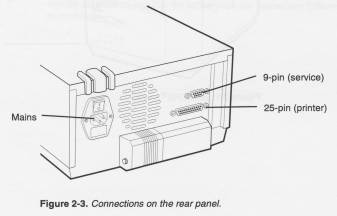
The touch screen provides the Interface for entering instructions and data to the Instrument, as well as displaying the results of measurements. Buttons are displayed on the screen for the functions available at any given time. To issue an instruction, touch the screen lightly on the appropriate display button.
The screen can be turned on its supporting column and tilted from the vertical for adjustment to Standing or sitting working positions (Figure 2-4). The red buttons on the top and side of the screen column release the screen for turning and tilting adjustment respectively. The screen
locks automatically in the Chosen position. Take care not to trag your hand between the screen and the supporting column when you adjust the screen angle.
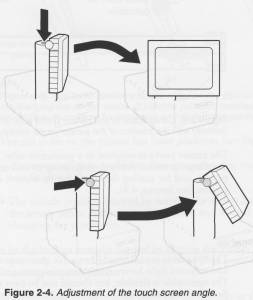
Pipette holder
A holder for the pipette is fitted on either the left or right side of the screen, according to which side you prefer to work (See Figure 3-1). The pipette should hang on the holder during measurements as well as when not in use.
The sensor probe
The sensor probe, where the actual detection takes place, is an optical fibre coated at the tip wich a gold layer (Figure 2-5). The detecting molecule is immobilized directly or indirectly an the surface to provide a biospecific sensor probe. A description of the surface characteristics and full instructions for immobilizing the detecting molecule and using the sensor probe are provided in a separate Sensor Probe Handbook.
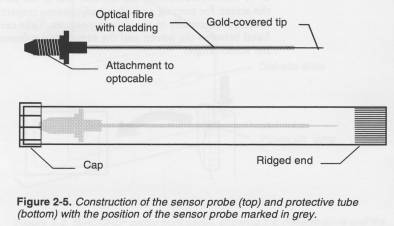
The sensor probe is supplied in a protective tube. The tube is used for handling the sensor probe during fitting to and removal from the pipette, and for storing the sensor probe when it is removed from the pipette (see Section 4.4).
The optocable
The optocable is an optical fibre cable that transmits both the incident and reflected light between the detection unit and the sensor probe, The optocable is flexible, but should not be bent tightly since this may damage the optical fibre in the cable. The minimum diameter of curvature for bending the cable is about 13 cm.
The pipette
BIACORE@probe uses a specially designed pipette to hold the sensor probe. The sensor probe protrudes into the pipette tip. Measurements are made on sample aspirated into the pipette tip.
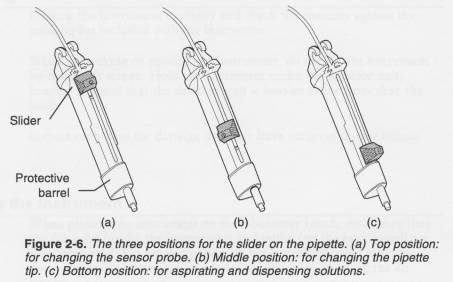
The red slider on the pipette has three positions (see Figure 2-6):
The top position is used when fitting or removing the sensor probe.
The middle position (locked by turning the slider) holds the tip of the sensor probe in the protective barrel, and is used when fitting or changing the pipette tip.
In the bottom position (locked by turning the slider), the sensor probe tip is extended into the pipette tip. This position is used when making measurements.
With the slider in the bottom position, the plunger at the top of the pipette aspirates and dispenses a fixed volume of about 100 µl. This is sufficient to cover the tip of the sensor probe when it is extended in the pipette tip. The pipette will only aspirate and dispense liquids when the slider is in the bottom position.
With the slider in the middle position, the plunger releases the pipette tip from the pipette.
Recommended pipette tips are 200 µl micropipette tips from Gilson.
Construction
Sensor Probe CM5 (Figure 2-1) consists of an optical fibre (diameter at the Sensor tip about 400 }.m) with a screw attachment for fitting to BIACORE®probe at one end. The fibre is covered with a protective cladding, except for 10 mm at the tip which is exposed to the solution being measured. This tip is coated with a thin layer of gold ( 50 nm thick) to provide conditions for SPR. The sensor probe is supplied in a capped protective tube which also serves as a holder when fitting the sensor probe to the probe holder an the Instrument.
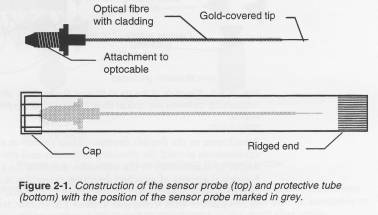
Surface properties
The gold film an the tip of Sensor Probe CM5 is covered with a layer of carboxymethylated dextran, covalently attached to the gold through an inert linker layer. The dextran is swollen in aqueous media, providing an extensively solvated hydrogel with a thickness of about 100 nm (Figure 2-2). The detecting molecule is attached to the dextran matrix either directly or through binding to a covalently immobilized capturing molecule. Carboxymethyl groups an the dextran supply convenient sites for attachment of proteins using well-defined chemistry.
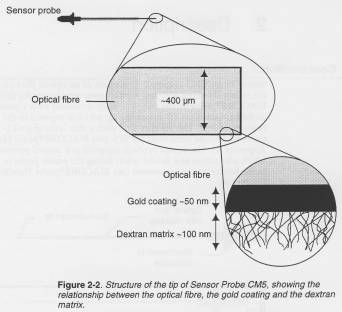
Attachment to the flexible dextran chains preserves a hydrophilic environment around the detecting molecules and provides a high degree of accessibility to the molecular surfaces. As a result, the biological activity of attached detecting molecules is retained to a high degree. This is a significant advantage of BIACORE°probe technology in comparison with techniques such as ELISA that rely an adsorption of proteins to plastic surfaces which can impair biological activity.
The dextran layer an Sensor Probe CM5 is chemically stable in most buffers used for preparing and studying biomolecules, and can be exposed to extremes of pH for short periods (2-3 minutes) without significant deterioration. In general, the stability of a functionalized sensor probe will be determined by the properties of the detecting molecule rather than of the dextran layer.
System specifications
Detection unit
Power supply 100-120/220-240 VAC auto-range 50-60 Hz
Maximum power consumption 160 W
Mains fuses 2 x T2.5AH
Light source Halogen lamp (expected lifetime at least 7000 hours)
Connection to sensor probe Optical fibre
Dimensions (1 x w x h) 420 x 340 x 440 mm
Weight 13.5 kg
Sample measurement
Detection principle Affinity-based biosensor using surface plasmon resonance
Dynamic range Refractive Index 1.33-1.40 (0-70 kRU)
Sample volume required ~100 µl (sample is not consumed)
Sample temperature 4-40°C
Analyse molecular weight > 10,000 daltons
Typical detection Limit 1 µg/ml using direct coupling*
2-5 µg/ml using capturing*
*Determined for myoglobin (molecular weight 17,000 daltons) using anti-myoglobin as detecting molecule.
Data storage
Internal data memory Flash disk
Sufficient for >1000 typical analyses
Working memory Sufficient for >1000 measurements per analysis
Diskette drive 3.5" 1.44 Mb PC-compatible
Accessories
Printer A Hewlett-Packard DeskJet printer is recommended for graphical printouts. For text-only printouts, an IBM ProPrinter or compatible may be used.
For conformance with European Standards, the printer muss be CEmarked in accordance with the Low Voltage Directive 73/23/EEC and the EMC Directive 89/336/EEC.
Environment
Instrument Operation
Temperature 15-35°C
Relative humidity 20-85% (non-condensing)
Noise level (LEQ) <40 dB(A)







